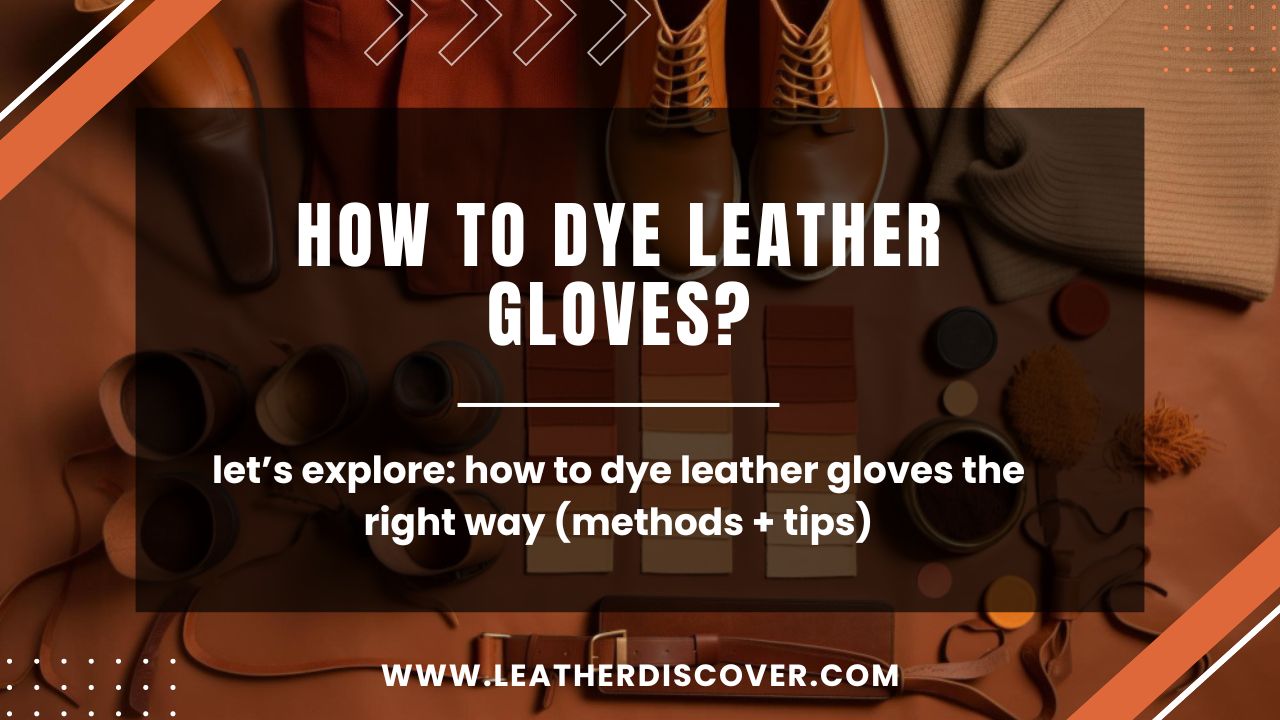Dyeing leather gloves is a creative and practical way to personalize or revitalize these timeless accessories.
Whether you want to change the color of your gloves, refresh their appearance, or add a unique touch to your fashion ensemble, dyeing offers a versatile solution.
I remember when I first tried dyeing my leather gloves, I was nervous about getting it right. But with the right approach, the results were fantastic.
In this guide, I’ll cover how to dye leather gloves, how long the dye lasts, and everything from choosing the right dye and preparing the gloves to applying the dye and ensuring a lasting, vibrant result.
Let’s get started and make your leather gloves look stunning again!
[toc]

How to Dye Leather Gloves?
Here’s a table to guide you through the leather glove dyeing process:
| Step | Materials Required | Purpose | Process |
|---|---|---|---|
| 1 | Leather gloves | Base material for dyeing | Ensure gloves are clean and free of dirt or oils. |
| 2 | Leather dye | Colorant for gloves | Choose a dye color of your preference. |
| 3 | Leather deglazer or acetone | Removes existing finish on gloves | Apply deglazer to remove any previous coatings. |
| 4 | Clean cloth or sponge | Application of deglazer and dye | Use a cloth or sponge to apply deglazer evenly. |
| 5 | Leather conditioner | Restores moisture and softness | Apply conditioner to keep the leather supple. |
| 6 | Clean, dry cloth | Buff and wipe the gloves | Remove excess conditioner and prep the leather for dyeing. |
| 7 | Leather dye applicator (brush/foam) | Applies dye evenly | Use an applicator to apply dye in thin, even coats. |
| 8 | Latex or nitrile gloves | Protects hands from dye | Wear gloves to prevent dye from staining your hands. |
| 9 | Plastic sheet or drop cloth | Protects work surface | Place beneath gloves to catch any drips or spills. |
| 10 | Ventilated workspace | Proper air circulation during dyeing | Ensure good ventilation to disperse fumes. |
| 11 | Time and patience | Allow for drying and multiple coats | Follow dye manufacturer’s instructions for drying times. |
| 12 | Fine-grit sandpaper (optional) | Smooths any rough areas | Use gently to even out the leather surface if needed. |
| 13 | Leather sealer or finish | Protects and enhances the color | Apply to preserve the color and finish of the gloves. |
| 14 | Soft cloth or sponge | Application of sealer/finish | Use a cloth or sponge to apply the sealer evenly. |
| 15 | Drying rack or hanger | Allows gloves to air dry | Hang or place gloves on a rack to dry thoroughly. |
| 16 | Patience | Let the gloves dry completely | Ensure gloves are fully dry before use. |
Notes:
- Always follow the specific instructions provided by the leather dye and conditioner manufacturers.
- Test a small, inconspicuous area of the gloves with the dye and deglazer to ensure it achieves the desired color and effect before dyeing the entire glove.
- Leather dyeing can be messy, so take precautions to protect your workspace and clothing.
- Some dyes may require heat setting with a hairdryer or heat gun. Follow the dye manufacturer’s guidelines.
- Be patient and allow each layer of dye to dry thoroughly before applying additional coats.
What Kind of Dye Do You Use on Leather?
When dyeing leather, it’s crucial to use a dye specifically formulated for leather. Leather dyes are designed to penetrate the surface of the leather and provide a long-lasting, colorfast finish. There are two main types of leather dye:
1. Water-Based Leather Dye:
Water-based leather dyes are typically easy to work with and have a lower odor than solvent-based dyes. They are also more environmentally friendly. These dyes are ideal for leather projects that don’t require a high degree of durability or resistance to moisture.
2. Solvent-Based Leather Dye:
Solvent-based leather dyes are known for their durability and ability to penetrate deeply into the leather, providing a long-lasting and vibrant color. They are suitable for leather items that will be exposed to moisture, such as shoes or outdoor gear.
However, they often have a stronger odor and may require good ventilation during application.
Factors to Consider While Choosing a Leather Dye:
When choosing a leather dye, consider the following factors:
1. Leather Type:
Some dyes are formulated for specific types of leather, so check the product’s compatibility with your gloves’ leather type.
2. Color:
Leather dyes come in a wide range of colors, allowing you to choose the shade that best suits your preferences.
3. Finish:
Dyes can produce different finishes, including matte, semi-gloss, and high-gloss. Select a finish that matches your desired look.
4. Coverage:
Consider the amount of dye you’ll need based on the size and color of your leather gloves.
5. Application Method:
Some dyes are suitable for brushing or spraying, so choose one that aligns with your preferred application method.
How Do You Darken Brown Leather Gloves?
To darken brown leather gloves, you can follow these steps:
1. Clean the Gloves:
Start by cleaning the gloves with a leather preparer or deglazer to remove any surface oils, dirt, or previous finishes. Allow them to dry completely.
2. Choose a Leather Dye:
Select a leather dye in a shade that is slightly darker than the current color of your gloves.
3. Apply the Dye:
Wearing disposable gloves to protect your hands, use a clean cloth or sponge to apply the leather dye evenly to the gloves. Work in small sections, and apply multiple coats if needed for the desired darkness. Allow each coat to dry before applying the next.
4. Condition and Buff:
After the gloves are dry, apply a leather conditioner or cream to keep the leather soft. Buff and polish the gloves with a clean, soft cloth to achieve a nice sheen.
5. Test and Care:
Perform a colorfastness test before wearing the gloves to ensure the dye is set. Follow care instructions for your specific leather type to maintain the darkened color.
How Long Does Leather Dye Last?
The longevity of leather dye depends on several factors, including the quality of the dye, the application process, and how well the leather is cared for.
High-quality leather dyes, applied correctly and followed by proper leather care, can last for years without significant fading or color loss.
However, leather is a natural material, and over time, exposure to sunlight, moisture, and wear can cause the color to fade gradually. Regular conditioning and protection can help extend the life of the dye.
Is It Better to Dye or Paint Leather?
The choice between dyeing and painting leather depends on your specific goals and the condition of the leather.
Dyeing is generally preferred when you want to change or enhance the color of the leather while maintaining its natural texture and flexibility. Dye penetrates the leather and provides a long-lasting, even color.
Painting leather is typically used for more dramatic transformations or when covering blemishes or stains. Leather paint creates a solid, opaque color and can be used to achieve unique effects or patterns.
Is Dyeing Leather Easy?
Dyeing leather can be a manageable DIY project, especially when working with leather dyes designed for consumers.
However, it does require attention to detail, patience, and proper preparation. The difficulty level can vary depending on factors such as the type of leather, the dye used, and the desired outcome.
Beginners may want to start with smaller, less valuable leather items or seek guidance from experienced leatherworkers to gain confidence and skill in the dyeing process.
Conclusion:
So, now you know how to dye leather gloves.
Dyeing leather gloves can breathe new life into these versatile accessories, allowing you to infuse your personal style into your wardrobe or restore their original vibrancy.
By following the careful steps outlined in this guide, you can confidently embark on your dyeing project, whether it’s to refresh the color, enhance the appearance, or embark on a creative endeavor.
With the right dye, preparation, and application techniques, you can achieve a lasting, customized result that not only reflects your individuality but also extends the life and versatility of your leather gloves.
- What Is Caiman Leather? A Detailed Guide - July 25, 2024
- What Is Tumbled Leather?A Complete Guide - July 25, 2024
- What Is Kip Leather? Premium Leather Choice - July 24, 2024

